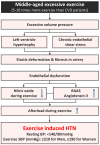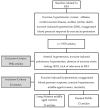Possible Mechanisms for Adverse Cardiac Events Caused by Exercise-Induced Hypertension in Long-Distance Middle-Aged Runners: A Review
- PMID: 38673457
- PMCID: PMC11050973
- DOI: 10.3390/jcm13082184
Possible Mechanisms for Adverse Cardiac Events Caused by Exercise-Induced Hypertension in Long-Distance Middle-Aged Runners: A Review
Abstract
Sudden cardiac death (SCD) is rare among athletes. However, hypertrophic cardiomyopathy is the leading cause of SCD among those <35 years of age. Meanwhile, coronary artery disease (CAD) is the primary SCD cause among those ≥35 years of age. CAD-induced plaque ruptures are believed to be a significant cause of cardiovascular diseases in middle-aged individuals who participate in extreme long-distance running activities such as marathons. A total of 1970 articles related to EIH were identified using search terms. Out of these, 1946 studies were excluded for reasons such as arterial hypertension, exercise-induced pulmonary hypertension, the absence of exercise stress testing (EST), and a lack of relevance to EIH. The study analyzed 24 studies related to both long-distance runners with exercise-induced hypertension (EIH) and the general public. Among these, 11 studies were quasi-experimentally designed studies used in randomized controlled trials (RCTs) on long-distance runners with EIH. Additionally, 12 studies utilized cohort designs, and one study with a quasi-experimental design was conducted among the general population. Recent studies suggest that an imbalance between oxygen demand and supply due to ventricular hypertrophy may be the actual cause of cardiovascular disease, regardless of CAD. Exercising excessively over an extended period can reduce endothelial function and increase arterial stiffness, which in turn increases afterload and leads to an excessive increase in blood pressure during exercise. Exercise-induced hypertension (EIH), which increases the morbidity rate of resting hypertension and is a risk factor for cardio-cerebro-vascular diseases, is more prevalent in middle-aged long-distance runners than in runners from other age groups, and it increases the prevalence of critical arrhythmias, such as atrial fibrillation or ventricular arrhythmias. EIH is associated with angiotensin II activity, and angiotensin II receptor blockers show promising effects in middle-aged runners. Further, guidelines for preventing excessive participation in races and restricting exercise intensity and frequency would be useful. This review identifies EIH as a potential risk factor for cardiovascular diseases and describes how EIH induces SCD.
Keywords: cardiac death; cardiovascular disease; exercise; hypertension; long-distance runner.
Conflict of interest statement
The authors indicate that they have no conflicts of interest regarding the content of this review paper.
Figures




Similar articles
-
Exercise-induced hypertension can increase the prevalence of coronary artery plaque among middle-aged male marathon runners.Medicine (Baltimore). 2020 Apr;99(17):e19911. doi: 10.1097/MD.0000000000019911. Medicine (Baltimore). 2020. PMID: 32332671 Free PMC article.
-
Prognostic Implications of Exercise-Induced Hypertension in Adults With Repaired Coarctation of Aorta.Hypertension. 2022 Dec;79(12):2796-2805. doi: 10.1161/HYPERTENSIONAHA.122.19735. Epub 2022 Oct 12. Hypertension. 2022. PMID: 36252107 Free PMC article.
-
Exercise-induced hypertension is associated with angiotensin II activity and total nitric oxide.Medicine (Baltimore). 2020 Jul 2;99(27):e20943. doi: 10.1097/MD.0000000000020943. Medicine (Baltimore). 2020. PMID: 32629698 Free PMC article.
-
Exercise-induced hypertension after aortic coarctation repair: Our experience and a systematic review.Kardiol Pol. 2024;82(6):625-631. doi: 10.33963/v.phj.100636. Epub 2024 May 20. Kardiol Pol. 2024. PMID: 38767163
-
Exercise-Induced Hypertension in Healthy Individuals and Athletes: Is it an Alarming Sign?Cureus. 2020 Dec 9;12(12):e11988. doi: 10.7759/cureus.11988. Cureus. 2020. PMID: 33437543 Free PMC article. Review.
Cited by
-
Characterizing hypertension among recreational cyclists in Colombia: The Atlántico cyclists study.Prev Med Rep. 2025 May 10;54:103105. doi: 10.1016/j.pmedr.2025.103105. eCollection 2025 Jun. Prev Med Rep. 2025. PMID: 40469252 Free PMC article.
-
Blood Flow Restriction Training as a Non-Pharmacologic Therapy with Exercise-Induced Hypertension.J Clin Med. 2025 Jun 23;14(13):4466. doi: 10.3390/jcm14134466. J Clin Med. 2025. PMID: 40648840 Free PMC article.
-
Machine Learning-Based Immuno-Inflammatory Index Integrating Clinical Characteristics for Predicting Coronary Artery Plaque Rupture.Immun Inflamm Dis. 2025 Apr;13(4):e70162. doi: 10.1002/iid3.70162. Immun Inflamm Dis. 2025. PMID: 40192067 Free PMC article.
References
-
- Eckart R.E., Shry E.A., Burke A.P., McNear J.A., Appel D.A., Castillo-Rojas L.M., Avedissian L., Pearse L.A., Potter R.N., Tremaine L., et al. Sudden Death in Young Adults: An Autopsy-Based Series of a Population Undergoing Active Surveillance. J. Am. Coll. Cardiol. 2011;58:1254–1261. doi: 10.1016/j.jacc.2011.01.049. - DOI - PubMed
-
- Arija V., Villalobos F., Pedret R., Vinuesa A., Jovani D., Pascual G., Basora J. Physical activity, cardiovascular health, quality of life and blood pressure control in hypertensive subjects: Randomized clinical trial. Health Qual. Life Outcomes. 2018;16:184. doi: 10.1186/s12955-018-1008-6. - DOI - PMC - PubMed
-
- Ried-Larsen M., Rasmussen M.G., Blond K., Overvad T.F., Overvad K., Steindorf K., Katzke V., Andersen J.L.M., Petersen K.E.N., Aune D., et al. Association of Cycling with All-Cause and Cardiovascular Disease Mortality Among Persons with Diabetes. JAMA Intern. Med. 2021;181:1196–1205. doi: 10.1001/jamainternmed.2021.3836. - DOI - PMC - PubMed
-
- Church T.S., Blair S.N., Cocreham S., Johannsen N., Johnson W., Kramer K., Mikus C.R., Myers V., Nauta M., Rodarte R.Q., et al. Effects of aerobic and resistance training on hemoglobin A1c levels in patients with type 2 diabetes: A randomized controlled trial. JAMA. 2010;304:2253–2262. doi: 10.1001/jama.2010.1710. - DOI - PMC - PubMed
Publication types
LinkOut - more resources
Full Text Sources
Research Materials
Miscellaneous

